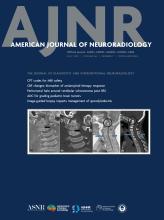Case of the Month
Section Editor: Nicholas Stence, MD
Children's Hospital Colorado, Aurora, CO
December 2016
Next Case of the Month coming January 10…
Dural Arteriovenous Fistula (AVF)
- Diagnosis:
- A 79-year-old woman was found to have a dural arteriovenous fistula (AVF) on CT and conventional angiography, causing venous hypertension and resultant venous hemorrhagic infarction.
- 3 days after the initial head CT, the dural AVF was successfully embolized with liquid agent and coils.
- Background:
- Intracranial dural AVFs occur more often in the infratentorial greater than in the supratentorial brain.
- The transverse and sigmoid sinuses are most commonly involved; however, any dural venous sinus may contribute.
- Classification of dural AVFs utilizing the Cognard system is based off of venous drainage and intracranial hemorrhage risk, as retrograde venous drainage correlates with a higher risk of hemorrhage.
- Clinical Presentation:
- Adult intracranial dural AVFs are typically acquired and are most often idiopathic, while pediatric intracranial dural AVFs are typically congenital.
- Symptoms range based on venous hypertension and location. Involvement of transverse/sigmoid sinuses can demonstrate pulsatile tinnitus, while involvement of the cavernous sinus can result in pulsatile exophthalmos and cranial nerve neuropathy.
- More severe symptoms include seizures, focal neurological deficits, encephalopathy, and progressive dementia.
- Key Diagnostic Features:
- Noncontrast imaging may be normal, unless intraparenchymal hemorrhage is present.
- Early filling of dural venous sinuses on arterial phase CT or conventional angiograms
- Engorged and tortuous vessels possibly adjacent to or extending from a cluster of tiny vessels (CT or MR)
- Differential Diagnosis:
- Dural venous thrombosis/stenosis resulting in venous hypertension, or variants resulting in asymmetric dural venous sinus filling (such as hypoplasia)
- Treatment:
- If low risk without significant symptoms, conservative management with follow-up imaging
- If high risk or significant symptoms, first line is typically endovascular embolization, with more invasive surgical techniques and radiosurgery as options for more complicated cases











